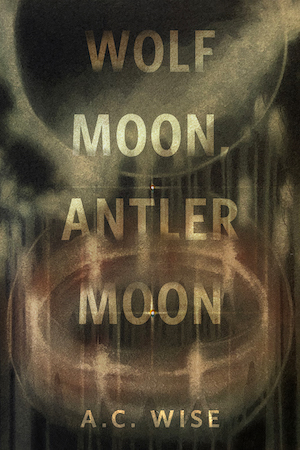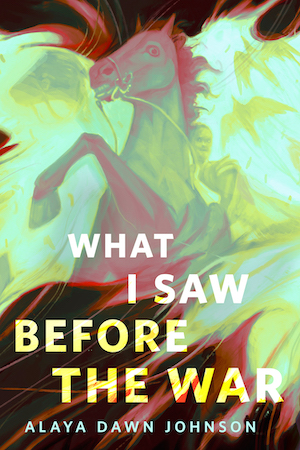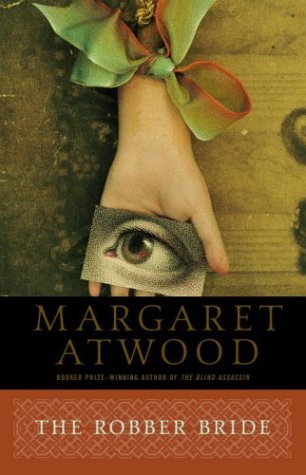Margaret Atwood attracted my attention by writing The Handmaid’s Tale, a feminist dystopian novel, in the late eighties. I liked it, in the kind of horrified trainwreck way in which one can like a book like that, and I proceeded to read everything she’d ever written, and then to read everything she wrote ever after. There are several interesting things about mainstream writers writing SF, and I’ve talked about some of them before. I don’t think I have mentioned though is that it’s often a sign that the mundane world isn’t enough for them, that they are becoming unsatisfied with the potential space of answers they can give to the questions they want to ask. It’s a sign they don’t want to keep writing the same thing over and over. Atwood of course has denied that she’s writing science fiction even with her middle-of-the-road SF novel Oryx and Crake (Greg Bear could have written that book) but the stories writers tell about their writing often aren’t as interesting as the stories they tell in it.
The Robber Bride is the story of the lives of three very different point of view characters: Tony, Charis, and Roz, and of Zenia, the Other Woman for all three of them, the villain. We see Tony and Charis and Roz very close up, from inside their heads, we find out about their childhoods and relationships and how they think. We only see Zenia in the shadow she casts in their lives. One of the nifty things Atwood is doing here is writing a feminist novel in which all the significant characters are women—in this book men only exist in bit parts, much the same way women are insignificant motivators and sex symbols in a lot of men’s literature. The other very clever thing she does is to write a story set in a specific time and place, Toronto between 1945 and 1990, but in which the possibility of magic is repeatedly flirted past the reader and at last confirmed within the universe of the novel. This is urban fantasy, but not as we know it.
What makes it one of my favourite Atwoods is the great characters. There’s Tony who reads words backwards and forwards and studies war. There’s Roz, who runs companies and comfort eats and frets about her children. And there’s Charis, who is a flake. No genre novel would give Charis real magic as she drifts around with her crystals and her herbal bath oils and ridiculous notions about how the world works. It’s quite an achievement that Atwood makes me sympathise with Charis, because people like her in real life tend to make me grind my teeth. (The only character like her I can think of in genre fiction is the woman who gets truly horrible things done to her by Aztecs in S.M. Stirling’s Island in the Sea of Time.) But Atwood sees her clearly as a rounded character, and her woowoo flaky magic is real.
The Robber Bride gets its title from the fairytale story of the “Robber Bridegroom,” a Bluebeard figure who marries girls and kills them. Roz’s twins at one point demand that all the characters in children’s stories be female; Winnie the Pooh and Piglet have to be “she” and so is the Big Bad Wolf and the Robber Bride. This of course reflects the thematic point that the book itself is doing this. It also reflects the fact that the book is itself a fairytale retelling, though not in a typical way. The mysterious and beautiful Zenia comes into the lives of all of the characters in turn, steals their partners and sucks out their life-force. She tells them different stories about her childhood and history, and in the end we learn nothing about her. She might as well be a succubus. She’s a blank space with sex wrapped around it. But the final question in the novel is “Are we in any way like her?” Zenia is the Other Woman, the bad woman, the one who steals the good women’s husbands, the one who is sexier and smarter and faster. She doesn’t just steal the men, she quite explicitly steals their souls. She lies. She makes herself up. But we see the others lie and recreate themselves—Tony and Roz manipulate their men, keep secrets from them and do not tell them the whole truth about their pasts. Charis doesn’t manipulate but her relationship with Billy is largely imaginary anyway. None of the men are very solid, but Charis isn’t a reliable narrator and we don’t get any triangulation on Billy except through Zenia.
The whole idea of an Other Woman stealing women’s men presupposes not only monogamy but that men have rightful owners. This isn’t a book about marriage or the potential shapes of romantic relationships—the only working romantic relationship we see that isn’t tentative or based on deception is a brief glimpse of a gay couple. What she’s doing here is excluding that and focusing on the patterns made by female relationships, friendly or antagonistic, and those shapes are what shape the story.
The book has a clever structure. The present takes a week, and is bookended by a lunch meeting and a dinner meeting between the three protagonists at a cafe called Toxique. These Toxique sections alternate points of view: Tony, Charis, Roz. Then the middle section is each woman’s life, Zenia story, and childhood, in the same order, each told as a flashback specifically anchored in the present but going much closer than you’d usually expect in the term “flashback.” Tony the historian, with her reversal of words and fascination with battles, is the most sympathetic character to me, but Atwood also makes me care about the other two.
[Tony] marks with her left hand, using different coloured pencils, which she holds between the fingers of her right hand like brushes: red for bad comments, blue for good ones, orange for spelling mistakes, and mauve for queries. Sometimes she reverses hands. When each paper is finished, she drops it onto the floor, making a satisfying flurry. To combat boredom she sometimes reads a few sentences out loud to herself, backwards.
Charis takes her quartz pendulum out of its blue silk Chinese bag—silk conserves the vibrations, says Shanita—and holds it over her head, watching it in the mirror. “Will this be a good day?” she asks it. Round and round means yes, back and forth means no. The pendulum hesitates, begins to swing, a sort of ellipse. Normal, thinks Charis. Then it gives a sort of jump and stops. Charis is puzzled: she’s never seen it do that before.
[Roz] shuffles into the bathroom, drinks two glasses of water to replenish her cells, takes her vitamin pill, brushes her teeth, creams, wipes, vivifies, and resurfaces her skin, and frowns at herself in the mirror. Her face is silting up, like a pond, layers are accumulating. Every once in a while, when she can afford the time, she spends a few days in a spa north of the city, drinking vegetable juice and having ultrasound treatments, in search of her original face, the one she knows is under there somewhere, she comes back feeling toned up and virtuous, and hungry. Also annoyed with herself. Surely she isn’t still trying, surely she isn’t still in the man pleasing business? She’s given that up. I do it for me, she tells Tony.
They’re all capable women. Even Charis earns her own living and has successfully brought up a child alone—and since her magic is real, in some ways she’s the most capable of them all. They’re not exactly happy, all of them have had terrible childhoods and Zenia has fractured their adult lives. Having seen them all close up in their own heads, it’s interesting to see them the way they see each other, and also the way Zenia sees them, or says she does. Zenia is often seen by them in sexual terms, and the way she describes them all is also sexual, and supposedly told her by their men. In bed, she says that Tony is like a gerbil, Roz a cement mixer, and Charis a turnip.
This isn’t really a fantasy novel. It’s a mainstream novel with the focus on people’s lives and motivations. But it’s a mainstream novel that doesn’t want to be limited to the quotidian, a mainstream novel that is leaning over into fairytale and magic to widen its possibilities. It’s much more interesting for that, for the fairytale parallels and the depth that allows, and for what it does with Charis.










